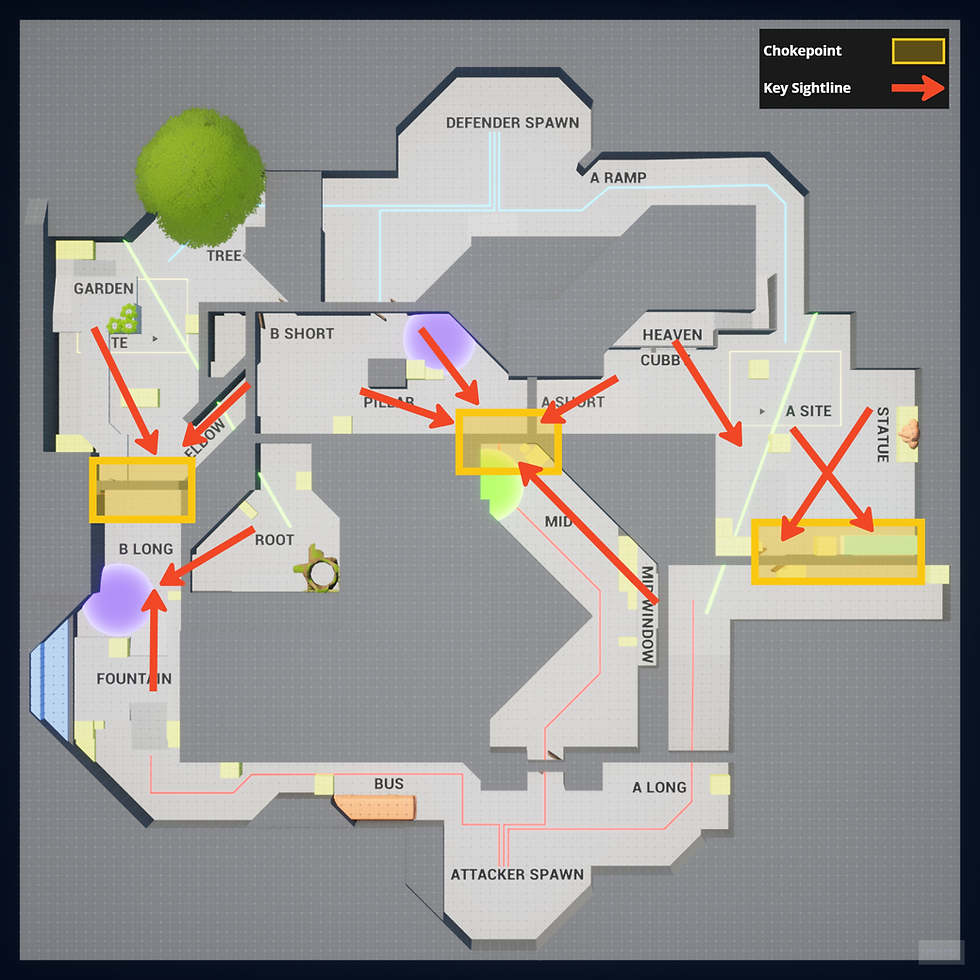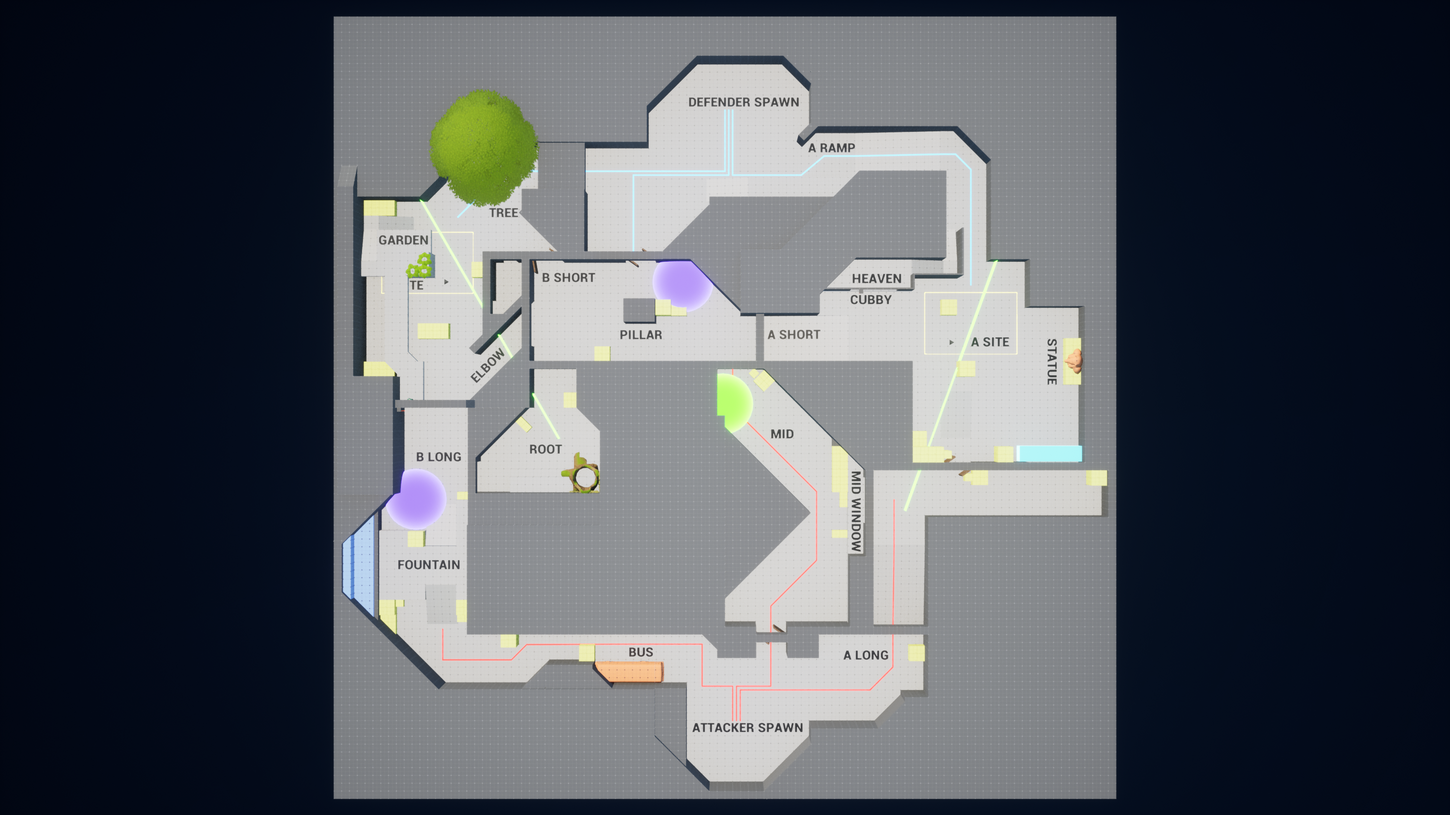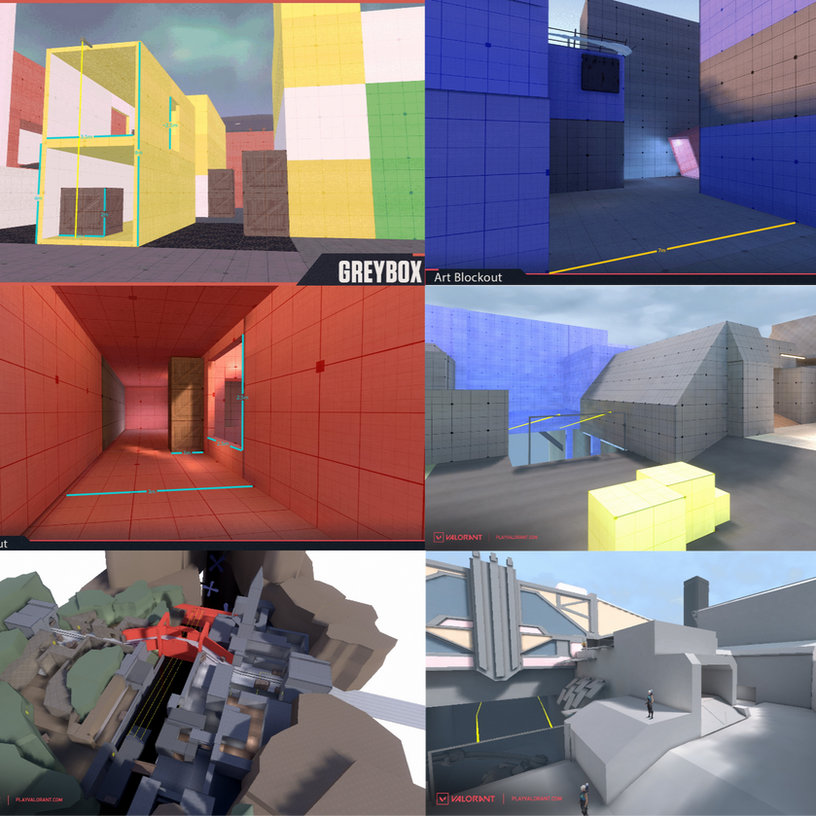
ROLE
Level Designer
INSPIRATION
Valorant
ENGINE
Unreal Engine 5
TOOLS
Miro
INFERNO
Having played Valorant almost daily for some time, I set out to challenge myself by designing a Valorant map in 24 hours. And while Valorant unfortunately lacks an official level editor, I decided to take on the challenge of researching, understanding and creating my own collection of standards which conform to Valorant's existing standards. A summarized version of my findings on Valorant in the form of a reference sheet can be found on the 'Resources' section of this website.
Valorant maps, just like Counter-Strike, mostly follow the Four-Square pattern popularized by Valve: 2 objective sites and 2 spawn points. They also include a middle lane connecting both spawn points together, one long path from each spawn points to the spike sites and an extra path from the middle lane into the spike sites. Spike sites are also typically situated closer to the defender spawn, giving them more time to prepare the spike site with utility if need be.

Research
While I do enjoy freeform level design, blocking out for a project like Valorant does require specific metrics and standards to be followed. With the lack of an official level editor, this set of standards would have to be researched and collected elsewhere.
Luckily, Riot Games often share behind-the-scenes looks at their projects through developer blogs. Not only do these articles include screenshots of some Valorant maps in different stages of the pipeline, they are also accompanied by commentary by the designers themselves. Since some screenshots showed certain maps at the blockout stage, I was able to gather a set of important metrics by reading the world grid material on each mesh. This initial pass gave me the metrics for the standing hard cover, crouch cover, windows, doors and some hallways.
With those metrics in mind, I ventured into the game itself to confirm what I had measured by using the tactical ping system. Pinging a location on the map measures and shows the distance to that location from your character, meaning the ping system can be used as a measuring tape. This is a method I have also used while designing custom levels for other games such as Rainbow Six: Siege.
Lastly, I gathered a collection of topdown layouts for every Valorant map released to-date, studying similarities and differences to create some general rules that all or most maps follow. Some of my findings include:
-
Valorant maps mostly follow the four-square pattern with 2 spike sites and 2 spawn points
-
Spike sites are situated closer to defenders spawn, allowing more time to setup each site with utility
-
Hard 90-degree corners are often softened for smoother movement and safer entry into certain areas
A summarized collection of my findings can be found on the 'Resources' section of this website.

Kitbash, materials & mock-up set
While I very much enjoy freeform designs, blocking out for Valorant does require at least a basic kitbash set to conform to existing metrics and standards.
Using the reference images discussed earlier, I put together a 2m standing cover, 1m crouch cover, standard 3m-tall window and double doors. I also included a spike mock-up to experiment with different plant spots in each site.
Next to those assets I also created scale mock-ups of some key Agent abilities such as Omen's smoke orb, Viper's toxin screen and Sage's ice wall. These proved to be very helpful when testing and balancing angles and entries at the micro level once the blockout had progressed further. Having the visual memory from playing Valorant almost daily for some time, I found it rewarding to be able to balance layouts around different types of utility. While not all Agent abilities were represented in my mock-up set, it still proved to be a good representation of most, especially since many different Agents have the same premise behind certain abilities as other Agents.
A good example of this multi-use ability mock-up is Omen's smoke orb, which has the same metrics and shape as Astra, Jett, Brimstone and Viper's smokes. The same standard can be considered for Viper's smoke screen, which shares its shape with Phoenix's fire and even Neon's corridor to a degree.
Being able to quickly move different smoke mock-ups into corridors and openings to check / balance certain angles proved very useful throughout the micro blockout stage.

Layout
With Valorant following the Four-Square design, a basic layout on paper proved fairly simple. I started with 2 spike sites and 2 spawns on the outer edges of the map. A basic Four-Square map also requires a middle lane connecting both spawns while also providing an extra entry into each site. This extra entry is fought over by both teams and creates pressure to achieve more map control.
Pillar was added next as a classic plaza-like area with multiple entries and one central point of interest in the middle. This area acts as a hub, giving access to all 4 key locations on the map. Controlling Pillar is important for both teams since it gives easy access for rotates, retakes or site entries. Securing it also forces lurkers to take a longer way around.
Chokepoints
Inferno has 3 main chokepoints separating the bottom and top halves, one chokepoints leading into each site from attackers spawn and another from mid lane into pillar. Chokepoints at the entrance to each site through the safer A Long and B Long will incentivize looking for alternate routes which are provided through pillar and mid, leading players into the third chokepoint and encouraging interaction.
Sightlines
As with every Valorant map, Inferno includes different types of sightlines to encourage different engagement ranges which in turn make room for different compositions and weapons to be used. A key difference between A-Site and B-Site is their engagement ranges through sightlines, I will discuss this in detail further below. As with the rest of the map, most outer corridors include medium to long sightlines while hubs, connecting rooms and shortcuts host short sightlines for CQB. Having shorter engagement ranges in hubs and shortcuts levels the playing field if the two teams have different economies, taking away the long range advantage of rifles or snipers, making these shortcuts high-risk-high-reward.

Retakes & rotates
Attackers rotation from A Long are made easier by opening the Mid Window which shortens their path. From B Long, attackers can rotate through Root leading into Pillar which in turn gives them access to A Site or even to fake a rotate and go back to B through Elbow or B Short.
Defender rotates pre-plant mostly happen through defender spawn or Pillar, while retakes post-plant can go through Root and Mid Window, same routes attackers can use for a pre-plant rotate. This pattern is similar to other Valorant maps such as Lotus or Bind. Following the same standards allows for better readability of the map since players are subconsciously used to following this pattern of rotations.
Focusing short rotations and retakes to pass through a central hub like Pillar will give Pillar even more importance as far as map control is concerned. Next to a few hard corners backed by 2m standing cover, Pillar rotates can also be stopped from outside especially with an Op or Marshal from Statue in A-Site. Making this a prominent cross-map sniping angle similar to the classic CT into T-Spawn on Dust 2 from Counter-Strike, which allowed a risky sniper angle to almost cut the map in half and spot rotates.

Aiming to give each site its own distinct set of challenges and a unique playstyle in order to provide room for meaningful choices depending on team composition and available weapons. For example, choosing a site with more short range engagements than long range during an economy round. Which will eliminate the range advantage of the enemy team's rifles versus pistols.
A-Site
More open to long range engagements with minimal loose cover. Most hard cover is spread around the outer edges, allowing for longer lines of sight into entries. Includes an elevated window (heaven) overlooking all 3 site entries and into A Short. Its exposed nature is complemented with ease-of-access through a ramp near defender spawn. A cubby underneath heaven is an anchor or post-plant hiding spot.
B-Site
Balanced around short to medium range engagements with a decent spread of loose cover cutting long sightlines. Added verticality with the garden which can also serve as a site entry through a zipline from B Long, this is especially useful for screen smokers to run alongside and enter site from above. A small side-room is also included to serve as an anchor holding spot for a defender who can cover at least 2 site entries from that room.
A-Site take through A Short
B-Site take through B Long. Entrance is noisy, hard to clear so many angles. Needs another pass.

Noisy site entry
An issue I noticed during playtests was how noisy the view into B-Site was from B Long, there are too many possible angles for the attackers to worry about and enemy agents are harder to immediately spot if the background behind them is noisy and cluttered.
Reducing noise can often be done by lowering the amount of loose cover and clutter. Since hard cover placement is already minimal on B-Site, I decided to take a different approach and limit their visibility from entryways. This would create a tighter, more focused funnel for attackers to enter site while also solving the noisy cover placement from that angle.


















